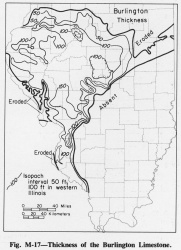Keokuk Limestone
Lithostratigraphy: Mammoth Cave Limestone Megagroup >>Keokuk Limestone
Chronostratigraphy: Paleozoic Erathem >>Mississippian Subsystem >>Valmeyeran Series
Allostratigraphy: Kaskaskia Sequence
Primary source
Willman, H. B., Elwood Atherton, T. C. Buschbach, Charles Collinson, John C. Frye, M. E. Hopkins, Jerry A. Lineback, and Jack A. Simon, 1975, Handbook of Illinois Stratigraphy: Illinois State Geological Survey Bulletin 95, 261 p.
Contributing author(s)
Elwood Atherton, Charles Collinson, and Jerry A. Lineback
Name
Original description
Keokuk Limestone (Owen, 1852, p. 91, 92; Hall, 1857, p. 190; Van Tuyl, 1925, p. 142).
Derivation
Named for Keokuk, Lee County, Iowa.
Other names
History/background
Type section
Type location
At the type locality about 70 feet of Keokuk Limestone overlying the Burlington Limestone is well exposed along Soap Creek and in the Mississippi River bluff near the mouth of the creek.
Type author(s)
Type status
Reference section
Reference location
Reference author(s)
Reference status
Stratigraphic relationships
Extent and thickness
The Keokuk occurs throughout much the same area as the underlying Burlington (fig. M-17), and it is well exposed along the Mississippi and Illinois Rivers in western Illinois. The Keokuk is 60-80 feet thick for much of its extent.
Lithology
Like the Burlington, the Keokuk is primarily a biocalcarenite. In the type region the lower 30 feet is very cherty and is differentiated as the Montrose Chert Member (Collinson, 1964). The part of the Keokuk above the Montrose is composed of beds of fossiliferous, crinoidal limestone interbedded with fine-grained limestone, argillaceous dolomite, and calcareous gray shale. The shale beds increase upward in number and thickness. The limestone is light gray, speckled with darker gray, brown, or black, and contains beds and nodules of chert. It is generally thinner bedded and darker than limestone of the Burlington, and the shale partings are more numerous. The contact with the overlying Warsaw Shale is gradational.
Core(s)
Photograph(s)
Contacts
Well log characteristics
Fossils
In contrast to the crinoidal limestone of the Burlington, the Keokuk shows a great heterogeneity of skeletal remains, with abundant bryozoans, corals, and brachiopods. The Keokuk contains bryozoans in much greater abundance and diversity than does the Burlington, with Archimedes and Worthenopora especially common. Distinctive brachiopods include Spirifer logani, Dictyoclostus crawfordsvillensis, Orthotetes keokuk, and Rotaia subtrigonia (Weller and Sutton, 1940). The conodont Gnathodus texanus--Taphrognathus Zone essentially coincides with the Keokuk Formation (Collinson et al., 1971).
Age and correlation
Environments of deposition
Economic importance
Remarks
References
COLLINSON, CHARLES, 1964, Western Illinois: 28th Annual Tri-State Field Conference, Quincy, Illinois, Illinois State Geological Survey Guidebook Series 6, 30 p.
COLLINSON, CHARLES, C. B. REXROAD, and T. L. THOMPSON, 1971, Conodont zonation of the North American Mississippian: Geological Society of America Memoir 127, p. 353-395; Illinois State Geological Survey Reprint 1972-A.
HALL, JAMES, 1857, Observations upon the Carboniferous limestones of the Mississippi Valley (abstract): American Journal of Science, v. 23, p. 187-203.
OWEN, D. D., 1852, Report of a geological survey of Wisconsin, Iowa, and Minnesota and incidentally of a portion of Nebraska Territory: Philadelphia, 638 p.
VAN TUYL, F. M., 1925, Stratigraphy of the Mississippian formations of Iowa: Iowa Geological Survey, v. 30, p. 33-349.
WELLER, J. M., and A. H. SUTTON, 1940, Mississippian border of Eastern Interior Basin: American Association of Petroleum Geologists Bulletin, v. 24, p. 765-858; Illinois State Geological Survey Report of Investigations 62.
ISGS Codes
| Stratigraphic Code | Geo Unit Designation |
|---|---|
